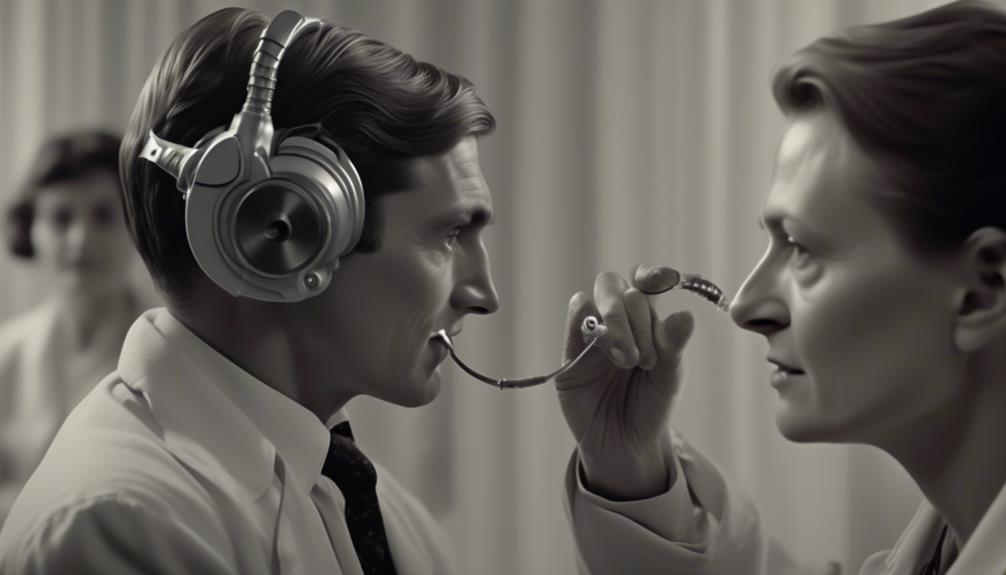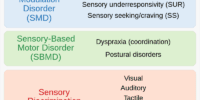Development of the Cochlear Implant (1961) – Djourno & Eyriès: Recap and Summary: Invented First Successful Cochlear Implant

The cochlear implant is a device that is surgically implanted into the inner ear to bypass damaged or non-functioning hair cells. It directly stimulates the auditory nerve, allowing individuals with profound hearing loss to perceive sound. The implant consists of an external microphone and speech processor, which convert sound into electrical signals. These signals are then transmitted to the internal receiver-stimulator, which sends them to the electrode array in the cochlea. The electrodes stimulate the auditory nerve fibers, which send signals to the brain for interpretation as sound. This groundbreaking technology has significantly improved the quality of life for individuals with severe to profound hearing loss, enabling them to communicate, enjoy music, and participate in everyday activities.
Key Takeaways
- Djourno and Eyriès conducted one of the earliest studies on cochlear implants in the 1960s, paving the way for future advancements in the field.
- Cochlear implants have revolutionized the treatment of severe hearing loss, significantly improving hearing outcomes and quality of life for patients.
- Early cochlear implants had limitations in sound quality and speech perception, but advancements in technology and research have led to significant improvements.
- Future developments in cochlear implant technology hold promise for further enhancing auditory perception and communication abilities, with advancements in signal processing, electrode design, and integration with other sensory modalities.
Early Studies on Auditory Stimulation
During the early stages of cochlear implant development, researchers actively investigated the effects of auditory stimulation on individuals with hearing loss. Early studies focused on understanding how auditory stimulation could potentially restore hearing function in those with severe to profound hearing loss. These studies aimed to assess the effectiveness and safety of cochlear implants as a viable treatment option.
One of the earliest studies conducted in the 1960s by Djourno and Eyriès demonstrated the potential of auditory stimulation through electrical impulses. They implanted an electrode array directly into the cochlea of individuals with hearing loss, and electrical signals were transmitted to the auditory nerve. The results of their study showed that individuals were able to perceive sound and understand speech to some extent.
Other early studies explored different methods of auditory stimulation, such as using single-channel and multichannel cochlear implants. These studies sought to determine the optimal number of electrodes and stimulation strategies for maximizing speech perception and understanding.
Djourno & Eyriès: The Pioneers of Cochlear Implants
You are about to explore the groundbreaking invention of cochlear implants by Djourno and Eyriès, who are recognized as the pioneers in this field. Their work is considered a milestone in auditory technology, as it opened up new possibilities for individuals with severe hearing loss.
Through their pioneering efforts, they laid the foundation for the development of modern cochlear implants, revolutionizing the field of audiology.
Groundbreaking Implant Invention
The groundbreaking invention of cochlear implants by Djourno and Eyriès revolutionized the field of auditory prosthetics, paving the way for significant advancements in restoring hearing abilities for individuals with severe hearing loss.
These implants have proven to be highly effective in improving hearing outcomes and patient satisfaction. Studies have shown that cochlear implants can provide a significant improvement in speech recognition and sound perception for individuals who are unable to benefit from traditional hearing aids.
In fact, research has demonstrated that cochlear implants can lead to substantial improvements in speech understanding, with some patients achieving near-normal levels of hearing.
Moreover, patient satisfaction rates with cochlear implants are consistently high, with many reporting significant improvements in their quality of life and communication abilities.
The remarkable effectiveness and high patient satisfaction levels highlight the immense impact of Djourno and Eyriès' groundbreaking invention in the field of auditory prosthetics.
Djourno & Eyriès' Pioneering Work
Djourno and Eyriès' pioneering work in the field of auditory prosthetics laid the foundation for the development of cochlear implants, revolutionizing the way severe hearing loss is treated.
Their collaboration led to the creation of early implant prototypes that paved the way for the successful cochlear implant we've today.
In the 1950s, Djourno, a physicist, and Eyriès, an otolaryngologist, recognized the potential of electrical stimulation in restoring hearing. They conducted experiments on animals, implanting electrodes into the cochlea to stimulate auditory nerve fibers.
Through their meticulous research and innovative thinking, they demonstrated that electrical stimulation of the auditory system could produce a sensation of sound.
Their groundbreaking work marked the beginning of a new era in auditory prosthetics, and their contributions continue to benefit millions of people worldwide.
Milestone in Auditory Technology
Eyriès and Djourno's groundbreaking work on cochlear implants marked a significant milestone in auditory technology, revolutionizing the treatment of severe hearing loss. Their innovative research paved the way for the development of cochlear implants, which have transformed auditory rehabilitation for individuals with profound hearing impairment.
Cochlear implants are surgically implanted electronic devices that bypass damaged hair cells in the inner ear and directly stimulate the auditory nerve, allowing sound signals to be transmitted to the brain. Through extensive cochlear implant research, it has been demonstrated that these devices can provide remarkable improvements in speech perception and sound localization.
This advancement in auditory technology has opened up new possibilities for individuals with severe hearing loss, enhancing their ability to communicate and participate fully in social and professional settings.
The Design and Functionality of the First Cochlear Implant
Researchers successfully developed and implemented the first cochlear implant, revolutionizing the field of auditory prosthetics. The design principles and functionality of the first cochlear implant were crucial in achieving this groundbreaking achievement.
- Internal and External Components: The first cochlear implant consisted of both internal and external components. The internal part, surgically implanted beneath the skin, included an electrode array that was inserted into the cochlea, as well as a receiver-stimulator that received and processed sound signals. The external part consisted of a microphone, a speech processor, and a transmitter that sent electrical signals to the internal components.
- Electrical Stimulation: The cochlear implant utilized electrical stimulation to bypass the damaged hair cells in the cochlea and directly stimulate the auditory nerve fibers. The electrode array, when activated by the receiver-stimulator, generated electrical signals that were then transmitted to the auditory nerve, allowing the brain to interpret them as sound.
- Signal Processing and Mapping: The speech processor played a vital role in signal processing and mapping. It converted sound signals into electrical signals, which were then delivered to the electrode array. The mapping process involved assigning specific electrical stimulation levels to different regions of the cochlea, based on the individual's specific hearing needs and the frequency range of sounds.
The design and functionality of the first cochlear implant paved the way for further advancements in auditory prosthetics, enabling individuals with profound hearing loss to regain the ability to perceive sound and significantly improving their quality of life.
Surgical Procedure: Implantation Process and Techniques
After understanding the design and functionality of the first cochlear implant, it's important to now explore the surgical procedure involved in the implantation process and the various techniques used.
The surgical procedure for cochlear implantation involves several steps that are carried out with precision and care. First, a small incision is made behind the ear to access the cochlea. Then, a hole is drilled in the skull bone to create a pathway for the electrode array. The electrode array is carefully inserted into the cochlea, ensuring proper placement and alignment. Once the electrode array is in position, the incision is closed, and the patient is moved to the recovery room for post-operative care.
During the surgical procedure, there are potential risks that need to be considered. These risks include infection, damage to the facial nerve, and damage to the inner ear structures. However, advancements in surgical techniques and technology have significantly reduced these risks.
Post-operative care is crucial for the success of the cochlear implant. This includes regular check-ups, monitoring for any signs of infection or complications, and rehabilitation therapy to help the patient adapt and learn to use the implant effectively.
Initial Results and Challenges Faced
You will now explore the initial results and challenges faced in the development of the cochlear implant.
Early implant limitations were encountered, such as poor sound quality and limited speech understanding.
However, through the patient adaptation process and advancements in technology, these challenges were gradually overcome, leading to improved outcomes and enhanced hearing restoration.
Early Implant Limitations
Despite early limitations, the development of the cochlear implant has paved the way for groundbreaking advancements in auditory rehabilitation.
However, in its early stages, the cochlear implant faced several challenges and limitations.
- Limited sound quality: The early cochlear implants had a limited number of electrodes, which resulted in a low-resolution sound perception. Users experienced difficulties in distinguishing between different speech sounds and had difficulty understanding speech in noisy environments.
- Surgical complications: Implantation surgery was a complex procedure with potential risks such as damage to the facial nerve and infection. Furthermore, the early implants required large external devices, making the surgery more invasive.
- Limited candidacy: Initially, only individuals with severe to profound hearing loss were considered suitable candidates for cochlear implants. Those with residual hearing or auditory processing difficulties were excluded from receiving this intervention.
These early limitations and challenges have been addressed through ongoing research and technological advancements, leading to significant improvements in the effectiveness and accessibility of cochlear implants.
Patient Adaptation Process
The initial results of the patient adaptation process for cochlear implants revealed both positive outcomes and significant challenges. Patient rehabilitation following implantation plays a crucial role in optimizing the benefits of the device.
Post-implant support is essential to help patients navigate the adjustment period and maximize their communication abilities. While some patients experienced significant improvements in speech perception and sound recognition, others encountered difficulties in adapting to the new auditory input.
Challenges included relearning sound interpretation, adjusting to the quality of sound perception, and overcoming limitations in speech perception in complex listening environments. Patient adaptation varied depending on individual factors such as age, duration of deafness, and cognitive abilities.
These findings highlight the importance of tailored rehabilitation programs and ongoing support to address the challenges faced by cochlear implant recipients.
Technical Hurdles Overcome
Following the patient adaptation process, the development of the cochlear implant faced initial results and significant challenges in overcoming technical hurdles. However, through continuous research and technical advancements, these obstacles were gradually overcome.
Here are three key findings from the research:
- Electrode Design: Researchers discovered that the design and placement of the electrode array played a crucial role in the effectiveness of the cochlear implant. They experimented with various electrode configurations to optimize auditory stimulation and improve speech perception.
- Signal Processing Algorithms: Developing sophisticated signal processing algorithms was another major breakthrough. These algorithms helped in decoding and translating sound signals into electrical impulses that the brain could interpret. Over time, researchers refined these algorithms to enhance speech recognition and sound localization.
- Miniaturization: Shrinking the size of the cochlear implant was a significant technical advancement. Miniaturization allowed for easier implantation and improved patient comfort. Researchers worked on developing smaller and more efficient devices without compromising their functionality.
These technical advancements and research findings paved the way for the successful development of the cochlear implant, revolutionizing the lives of individuals with hearing loss.
Advancements in Technology: Improving the Cochlear Implant
Advancements in technology have greatly enhanced the functionality and efficacy of the cochlear implant, revolutionizing the way individuals with hearing loss perceive sound.
One significant improvement is the introduction of wireless connectivity, which has eliminated the need for cumbersome cables and allowed for seamless integration with other devices. With wireless connectivity, cochlear implant users can easily connect their implants to smartphones, tablets, and other audio devices, enabling them to stream music, make phone calls, and engage in video chats with improved clarity and ease.
Another advancement that has significantly improved the cochlear implant is speech recognition technology. Speech recognition algorithms have become increasingly sophisticated, allowing the implant to better differentiate and interpret speech sounds. This has led to improved speech understanding and communication for cochlear implant users.
In addition, advanced signal processing algorithms have been developed to enhance the quality of sound perception, providing a more natural and rich auditory experience.
Furthermore, advancements in electrode design have led to improved spatial resolution, allowing cochlear implant users to better distinguish between different pitches and perceive more nuanced sounds. This has resulted in enhanced music appreciation and improved speech perception in noisy environments.
Impact on the Hearing Impaired Community
The implementation of cochlear implant technology has had a profound impact on the hearing impaired community, providing individuals with enhanced auditory perception and improved communication abilities. This groundbreaking technology has revolutionized the lives of those with hearing loss, offering them an opportunity to regain a sense of sound and reconnect with the world around them.
Cochlear implant accessibility: With advancements in technology and increased awareness, cochlear implants have become more accessible to a wider range of individuals. This has allowed more people with hearing loss to benefit from this life-changing technology.
Psychological impact: Cochlear implants not only improve auditory perception but also have a significant psychological impact on individuals. The ability to hear and understand speech can enhance self-esteem, boost confidence, and improve overall quality of life. It can also reduce feelings of isolation and improve social interactions, leading to a stronger sense of belonging within the hearing impaired community.
Improved communication abilities: Cochlear implants enable individuals to effectively communicate with others, whether it be through spoken language or sign language. By providing access to sound, cochlear implants allow individuals to participate more fully in conversations, engage in social activities, and pursue educational and professional opportunities.
Future Innovations and Potential Breakthroughs
Innovative research and technological advancements continue to pave the way for future breakthroughs in cochlear implant technology, promising even greater improvements in auditory perception and communication abilities for individuals with hearing loss.
The field of cochlear implants has already come a long way since its inception, and it shows no signs of slowing down.
One potential future innovation in cochlear implant technology is the development of more advanced electrode arrays. Currently, cochlear implants use a small number of electrodes to stimulate the auditory nerve, allowing individuals to perceive sound. However, researchers are exploring the possibility of increasing the number of electrodes to provide even more precise stimulation. This could lead to improved speech perception and sound localization, as well as better music appreciation.
Another potential breakthrough lies in the field of signal processing. As technology continues to advance, there's a growing opportunity to optimize the way cochlear implant systems process sound. This includes improving the algorithms used to convert sound into electrical signals that can be understood by the brain. By refining these algorithms, researchers hope to enhance speech understanding in noisy environments and expand the range of sounds that can be perceived by cochlear implant users.
Furthermore, the future of cochlear implants may involve integrating additional sensory modalities, such as incorporating visual or tactile cues to enhance auditory perception. This multimodal approach could provide individuals with more comprehensive and naturalistic auditory experiences.
Frequently Asked Questions
What Were Some of the Challenges Faced by Djourno and Eyriès During Their Early Studies on Auditory Stimulation?
During their early studies on auditory stimulation, Djourno and Eyriès faced challenges in effectively stimulating the auditory nerve and achieving consistent results. These obstacles required innovative solutions and further research in order to develop the first successful cochlear implant.
How Has the Design and Functionality of the First Cochlear Implant Evolved Over Time?
Over time, the design and functionality of the first cochlear implant have evolved significantly. Advancements in technology have led to improved speech perception and sound quality, while surgical techniques have become more precise. These developments have had a profound impact on individuals, providing them with the freedom to hear and communicate. However, challenges such as electrode placement and limited battery life still persist.
What Are the Different Implantation Processes and Techniques Used During the Surgical Procedure?
During the surgical procedure for a cochlear implant, different implantation techniques are utilized. These techniques involve precise placement of the implant and electrode array into the cochlea, ensuring optimal auditory stimulation for the recipient.
Can You Provide Some Examples of the Advancements in Technology That Have Improved the Cochlear Implant?
Advancements in technology have greatly improved the cochlear implant. Examples include smaller and more powerful processors, wireless connectivity, improved electrode designs, and advanced signal processing algorithms, enhancing the overall performance and user experience.
How Has the Cochlear Implant Impacted the Lives of Individuals in the Hearing Impaired Community?
The cochlear implant has greatly impacted the lives of individuals in the hearing impaired community by improving their communication and overall quality of life.









